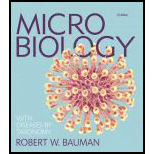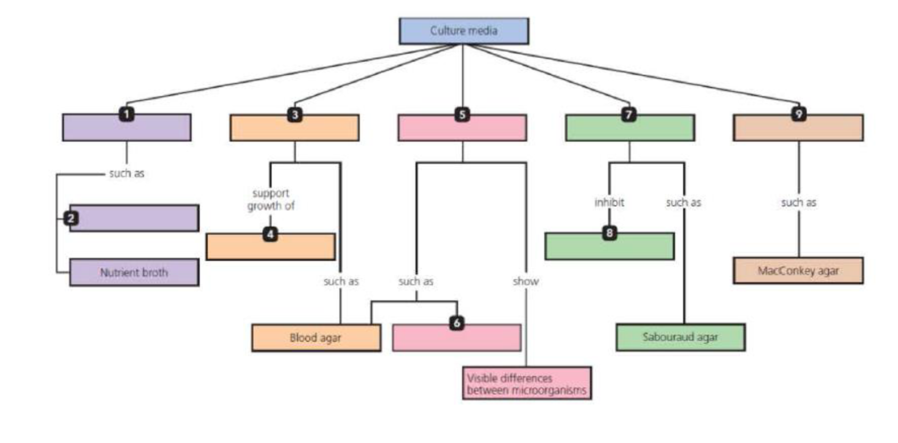
Microbiology with Diseases by Taxonomy (5th Edition)
5th Edition
ISBN: 9780134019192
Author: Robert W. Bauman Ph.D.
Publisher: PEARSON
expand_more
expand_more
format_list_bulleted
Textbook Question
Chapter 6, Problem 1CM
Using the following terms, fill in the following concept map that describes culture media. You can also complete this and other concept maps online by going to the Mastering
Blood agar
Differential
Enriched
Fastidious microorganisms
Fermentation broths (such as phenol red)
General purpose
MacConkey agar
Nutrient broth
Sabouraud agar
Selective
Selective and differential
Trypticase soy agar
Unwanted microorganisms
Visible differences between microorganisms

Expert Solution & Answer
Trending nowThis is a popular solution!

Students have asked these similar questions
The following is a Mannitol Salt Agar plate. What does the yellow color on the right
side of this plate indicate?
TAW
ASM's MicrobeLibrary Ⓒ Reynolds
tolerance of the salt
mannitol metabolism
tolerance of the dyes and chemicals in the agar
lactose metabolism
Give Detailed explanation Solution (no need Handwritten)
Below is an image of 3 different bacteria, letter labeld, growing on MacConkey Agar.
Note that bacteria such as E. coli use mixed acid fermentation, with very high acid production which
will cause a colored precipitation around colonies on MacConkey agar.
MacConkey Agar
C
Chapter 6 Solutions
Microbiology with Diseases by Taxonomy (5th Edition)
Ch. 6 - Prob. 1MCCh. 6 - In the laboratory, a sterile inoculating loop is...Ch. 6 - Superoxide dismutase _____________. a. causes...Ch. 6 - The most reactive of the four toxic forms of...Ch. 6 - Microaerophiles that grow best with a high...Ch. 6 - Prob. 6MCCh. 6 - Organisms that preferentially may thrive in icy...Ch. 6 - Prob. 8MCCh. 6 - Prob. 9MCCh. 6 - In a defined medium, ______________. a. the exact...
Ch. 6 - Prob. 11MCCh. 6 - Prob. 12MCCh. 6 - Prob. 13MCCh. 6 - Lyophilization can be described as ___________. a....Ch. 6 - Prob. 15MCCh. 6 - Prob. 1FIBCh. 6 - Prob. 2FIBCh. 6 - Prob. 3FIBCh. 6 - Prob. 4FIBCh. 6 - Prob. 5FIBCh. 6 - Prob. 6FIBCh. 6 - Prob. 7FIBCh. 6 - Prob. 8FIBCh. 6 - Prob. 9FIBCh. 6 - Prob. 10FIBCh. 6 - Prob. 11FIBCh. 6 - Prob. 1VICh. 6 - Prob. 2VICh. 6 - High temperature affects the shape of particular...Ch. 6 - Support or refute the following statement:...Ch. 6 - Prob. 3SACh. 6 - Why must media, vessels, and instruments be...Ch. 6 - Prob. 5SACh. 6 - Prob. 6SACh. 6 - Draw and label the four distinct phases of a...Ch. 6 - Prob. 8SACh. 6 - Prob. 9SACh. 6 - Prob. 10SACh. 6 - Explain the differences among photoautotrophs,...Ch. 6 - Prob. 12SACh. 6 - How does a chemostat maintain a constant...Ch. 6 - A scientist describes an organism as a...Ch. 6 - Pasteurization is a technique that uses...Ch. 6 - Prob. 3CTCh. 6 - Some organisms require riboflavin (vitamin B2) to...Ch. 6 - A scientist inoculates a bacterium into a complex...Ch. 6 - How can regions within biofilms differ in their...Ch. 6 - A scientific article describes a bacterium as an...Ch. 6 - Prob. 8CTCh. 6 - Prob. 9CTCh. 6 - Starting with 10 bacterial cells per milliliter in...Ch. 6 - Prob. 11CTCh. 6 - Prob. 12CTCh. 6 - The filamentous bacterium Beggiatoa gets its...Ch. 6 - Prob. 14CTCh. 6 - Examine the graph in Figure 6.3. Note that the...Ch. 6 - Prob. 16CTCh. 6 - Using the terms in Figure 6.8a, describe the...Ch. 6 - Prob. 18CTCh. 6 - Examine the ingredients of MacConkey agar as...Ch. 6 - Prob. 20CTCh. 6 - Using as many of the following terms as...Ch. 6 - Prob. 22CTCh. 6 - Viable plate counts are used to estimate...Ch. 6 - Using the following terms, fill in the following...Ch. 6 - Prob. 1TMWCh. 6 - Why do clinical laboratory scientists keep many...Ch. 6 - Prob. 3TMWCh. 6 - Culturing Microorganisms One of Kochs postulates...Ch. 6 - Clinical Case Study Boils in the Locker Room For...
Knowledge Booster
Learn more about
Need a deep-dive on the concept behind this application? Look no further. Learn more about this topic, biology and related others by exploring similar questions and additional content below.Similar questions
- A student needed to transfer bacteria from a broth culture to an agar plate. Below is the step-by-step what was done to accomplish this. The transfer of bacteria was not successful because of which step? 1. Cap of the broth culture is removed 2. The mouth of the bottle is flamed 3. The loop was flamed 4. The loop was inserted into the culture to pick up the bacteria 5. The loop was flamed 6. The loop containing the bacteria was used to introduced to spread the agar plate 7. The plate was placed in an incubator at 30 Celciusarrow_forwardWhat are the primary uses of the following preparations of culture media? Agar regular slant Agar special slant Agar deep Broth Agar platearrow_forwardPLEASE ANSWER THE FOLLOWING QUESTIONS ABOUT THE PICTURES.arrow_forward
- You must write up your OWN dichotomous key for all the possible unknown organisms listed below. The first step of the key will be the Gram Stain and the second will be Gram negative. Subsequent steps will include biochemical tests only. Solve the identity of an unknown bacterial specimen by creating a dichotomous key and using the staining, culturing and biochemical identification procedures . Possible Organisms Alcaligenes faecalis Enterobacter aerogenes Enterococcus faecalis Escherichia coli Proteus vulgaris Pseudomonas aeruginosa Salmonella arizoniae Staphylococcus aureus Staphylococcus epidermidis Staphylococcus saprophyticus Streptococcusbovis Streptococcus pyogenes. Can you please help me find the dichotomous key . Thank you !arrow_forwardThe following is a picture of Eosin Methylene Blue Agar. What does the growth on this plate indicate? ASM MicrobeLibrary.org © Cheeptham Carrow_forwardLabel Differential Enriched Fastidious Microorganisms Fermentation broths General purpose Selective Sekective and Differential Trypticase Soy Agar Unwanted microorganismsarrow_forwardS aureus Styphimurium S aureus S typhimurium Nutrient Agar Plates MacConkey Agar Plates S epidermidis Unknown S epidermidis Unknown S aureus S typhimurium S aureus S typhimurium Mannitol Salt Agar Plates Gram Stain S epidermidis Unknown S epidermidis Unknownarrow_forwardAt the Brewery part 2: Continue identifying microbes you islated from the contaminated beer: Microbe 2: top photo growth on Sabauraud Dextrose agar; bottom microscopic viewarrow_forwardIndicate which of the following observations can be made when observing growth on nutrient agar. Check all that apply. please look at the attached imagearrow_forwardHave bacteria been successfully isolated on the Petri dish in this picture? ASM MicrobeLibrary.org © Katz Yes O Noarrow_forwardOne of the useful properties of agar is its inability to be digested by most microbes. True Falsearrow_forwardMacConkey agar inhibits the growth of Gram-positive bacteria while encouraging the growth of Gram-negative bacteria. It also can determine if some bacteria use lactose. Define what type(s) of media MacConkey agar is, using as many terms in the answer list as are applicable.arrow_forwardarrow_back_iosSEE MORE QUESTIONSarrow_forward_ios
Recommended textbooks for you
 Comprehensive Medical Assisting: Administrative a...NursingISBN:9781305964792Author:Wilburta Q. Lindh, Carol D. Tamparo, Barbara M. Dahl, Julie Morris, Cindy CorreaPublisher:Cengage Learning
Comprehensive Medical Assisting: Administrative a...NursingISBN:9781305964792Author:Wilburta Q. Lindh, Carol D. Tamparo, Barbara M. Dahl, Julie Morris, Cindy CorreaPublisher:Cengage Learning


Comprehensive Medical Assisting: Administrative a...
Nursing
ISBN:9781305964792
Author:Wilburta Q. Lindh, Carol D. Tamparo, Barbara M. Dahl, Julie Morris, Cindy Correa
Publisher:Cengage Learning

Infection Prevention and Control; Author: thecityoftoronto;https://www.youtube.com/watch?v=jx9sRYmBW3Q;License: Standard Youtube License